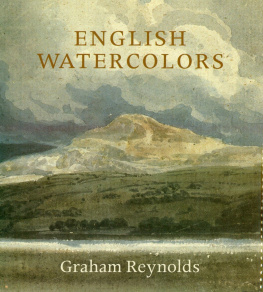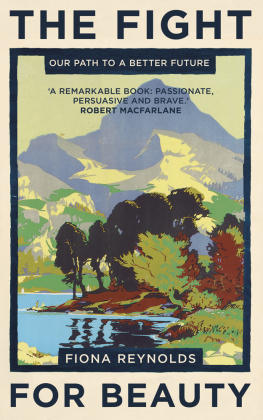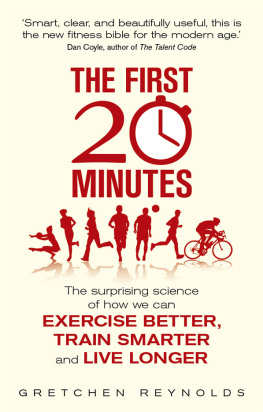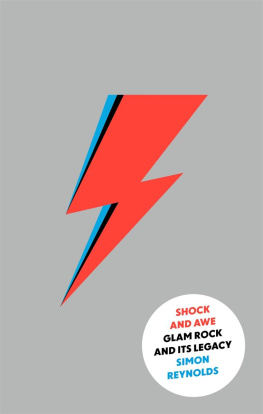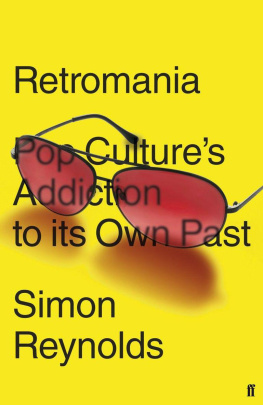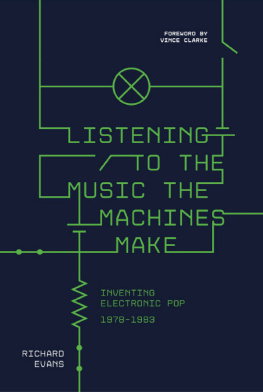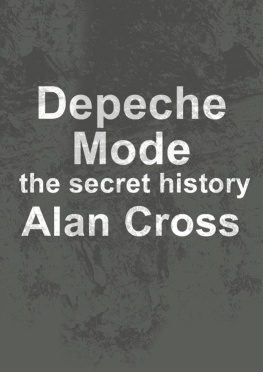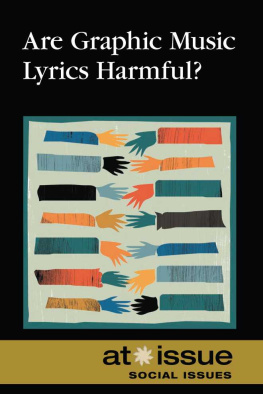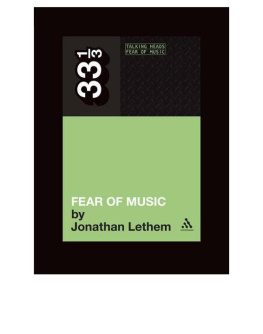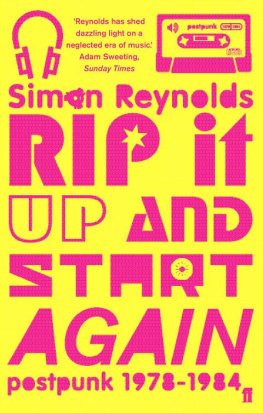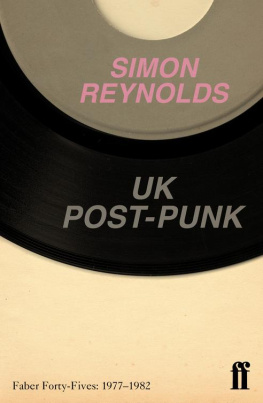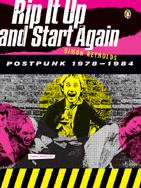Rip It Up and Start Again
POSTPUNK 19781984
SIMON REYNOLDS

PENGUIN BOOKS
PENGUIN BOOKS
Published by the Penguin Group
Penguin Group (USA) Inc., 375 Hudson Street, New York, New York 10014, USA
Penguin Group (Canada), 90 Eglinton Avenue East, Suite 700, Toronto, Ontario, Canada M4P 2Y3 (a division of Pearson Penguin Canada Inc.)
Penguin Books Ltd, 80 Strand, London WC2R 0RL, England
Penguin Ireland, 25 St Stephens Green, Dublin 2, Ireland (a division of Penguin Books Ltd.)
Penguin Group (Australia), 250 Camberwell Road, Camberwell, Victoria 3124, Australia (a division of Pearson Australia Group Pty Ltd)
Penguin Books India Pvt Ltd, 11 Community Centre, Panchsheel Park, New Delhi - 110 017, India
Penguin Group (NZ), cnr Airborne and Rosedale Roads, Albany, Auckland 1310, New Zealand (a division of Pearson New Zealand Ltd)
Penguin Books (South Africa) (Pty) Ltd, 24 Sturdee Avenue, Rosebank, Johannesburg 2196, South Africa
Penguin Books Ltd, Registered Offices:
80 Strand, London WC2R 0RL, England
First published in Great Britain by Faber and Faber Ltd 2005
First published in Penguin Books 2006
Copyright Simon Reynolds, 2005
All rights reserved
library of congress cataloging-in-publication data
Reynolds, Simon, 1963
Rip it up and start again: postpunk 19781984 / Simon Reynolds.
p. cm.
Includes index.
ISBN: 978-1-1012-0105-3
1. Rock music19711980History and criticism. 2. Rock music19811990History and criticism. 3. Punk rock musicHistory and criticism. I. Title.
ML3534.R492 2006
781.66'09047dc22
2005049348
Except in the United States of America, this book is sold subject to the condition that it shall not, by way of trade or otherwise, be lent, resold, hired out, or otherwise circulated without the publishers prior consent in any form of binding or cover other than that in which it is published and without a similar condition including this condition being imposed on the subsequent purchaser.
The scanning, uploading, and distribution of this book via the Internet or via any other means without the permission of the publisher is illegal and punishable by law. Please purchase only authorized electronic editions, and do not participate in or encourage electronic piracy of copyrighted materials. Your support of the authors rights is appreciated.
To my brother tim, WHO TURNED ME ON TO PUNK IN THE FIRST PLACE, my son kieran, AND IN MEMORY OF Rebecca Press AND Burhan Tufail
CONTENTS
1. Public Image Belongs to Me:
John Lydon and PiL
2. Autonomy in the U.K.:
DIY and the British Independent-Label Movement
3. Tribal Revival:
The Pop Group and the Slits
4. Militant Entertainment:
Gang of Four, the Mekons, and the Leeds Scene
5. Uncontrollable Urge:
The Industrial Grotesquerie of Pere Ubu and Devo
6. Living for the Future:
Cabaret Voltaire, the Human League, and the Sheffield Scene
7. Just Step Sideways:
The Fall, Joy Division, and the Manchester Scene
8. Industrial Devolution:
Throbbing Gristles Music from the Death Factory
9. Contort Yourself:
No Wave New York
10. Art Attack:
Talking Heads, Wire, and Mission of Burma
11. Messthetics:
The London Vanguard
12. Freak Scene:
Cabaret Noir and Theater of Cruelty in Postpunk San Francisco
13. Careering:
PiL and Postpunks Peak and Fall
14. Ghost Dance:
2-Tone and the Ska Resurrection
15. Sex Gang Children:
Malcolm McLaren, the Pied Piper of Pantomime Pop
16. Mutant Disco and Punk Funk:
Crosstown Traffic in Early Eighties New York (and Beyond)
17. Fun n Frenzy:
Postcard Records and the Sound of Young Scotland
18. Electric Dreams:
Synthpop
19. Play to Win:
The Pioneers of New Pop
20. New Gold Dreams 81-82-83-84:
New Pops Peak, the Second British Invasion of America, and the Rise of MTV
21. Dark Things and Glory Boys:
The Return of Rock with Goth and the New Psychedelia
22. Raiding the Twentieth Century:
ZTT, the Art of Noise, and Frankie Goes to Hollywood
For Discography and Discography Part 2: Postpunk Esoterica (the latter featuring extensive commentary) go to the Rip It Up and Start Again Web site at www.simonreynolds.net, which also contains footnotes, source notes, transcripts, interviews with the author, links, and other postpunk-related material.
INTRODUCTION
PUNK BYPASSED ME almost completely at first. Thirteen going on fourteen at the time, and growing up in an English commuter town, I only have the faintest memories of 1977. I vaguely recall photo spreads of spiky-haired punks in a Sunday newspaper magazine, but thats it really. The Sex Pistols swearing on television, God Save the Queen versus the Royal Jubilee, an entire culture convulsed and quakingI simply did not notice . As for what I was into and up to instead, well, its a bit of a haze. Nineteen seventy-seven, was that the year I wanted to be a cartoonist? Or, having moved onto science fiction, did I spend 1977 systematically working my way through the local librarys cache of Ballard, Pohl, Dick? All I know for sure is that pop music barely impinged on my consciousness.
My younger brother Tim got into punk first. There was always this god-awful racket coming through the bedroom wall. One of the many times I went in there to complain, I must have lingered. The profanity hooked me first (I was fourteen), Johnny Rottens fuck this and fuck that/Fuck it all and fuck her fucking brat. More than the naughty words themselves, it was the vehemence and virulence of Rottens deliverythose percussive fucks, the demonic glee of the rolled r s in brrrrrrrat. There have been a thousand carefully reasoned theses validating the movements sociocultural import, but if anyones really honest, the sheer monstrous evil of punk was a huge part of its appeal. Take the sickness of Devo, for example. Id never heard anything so creepy and debased as their early single Jocko Homo and its flip side, Mongoloid, brought around our house by a far more advanced friend.
When I got into the Pistols and the rest, at some point in the middle of 1978, I had no idea that this was all officially dead. The Pistols were long split. Rotten had already formed Public Image Ltd. Because Id been otherwise occupied and missed the entire birth, life, and death of punk, I also cannily skipped the mourning after, that sickening 78 crash experienced by almost everybody who was there and aware during the exhilarating 77 rush. My belated discovery of punk coincided with the period when things began to pick up again, with what soon became known as postpunk, the subject of this book. So I was listening to X-Ray Spexs Germfree Adolescents, but also the first PiL album, Talking Heads Fear of Music, and Cut by the Slits. It was all one bright, bursting surge of excitement.



